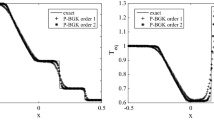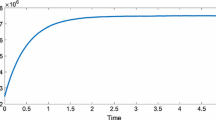Abstract
We propose two models of the Boltzmann equation (BGK and Fokker-Planck models) for rarefied flows of diatomic gases in vibrational non-equilibrium. These models take into account the discrete repartition of vibration energy modes, which is required for high temperature flows, like for atmospheric re-entry problems. We prove that these models satisfy conservation and entropy properties (H-theorem), and we derive their corresponding compressible Navier–Stokes asymptotics.
Similar content being viewed by others
References
Bird, G.A.: Molecular Gas Dynamics and the Direct Simulation of Gas Flows. Oxford Engineering Science Series. Oxford University Press, Oxford (2003)
Schwartzentruber, Thomas E., Boyd, Iain D.: Nonequilibrium Gas Dynamics and Molecular Simulation. Cambridge Aerospace Series. Cambridge University Press, Cambridge (2017)
Dimarco, G., Pareschi, L.: Numerical methods for kinetic equations. Acta Numer. 23, 369–520 (2014)
Mieussens, Luc: A survey of deterministic solvers for rarefied flows (invited). AIP Conf. Proc. 1628(1), 943–951 (2014)
Gross, E.P., Bhatnagar, P.L., Krook, M.: A model for collision processes in gases. Phys. Rev. 94(3), 511–525 (1954)
Chu, C.K.: Kinetic-theoretic description of the formation of a shock wave. Phys. Fluids 8(1), 12 (1965)
Struchtrup, H.: Macroscopic Transport Equations for Rarefied Gas Flows Approximation Methods in Kinetic Theory. Interaction of Mechanics and Mathematics. Springer, Heidelberg (2005)
Cercignani, C.: The Boltzmann Equation and Its Applications. Lectures Series in Mathematics, vol. 68. Springer, New York (1988)
Gorji, M.H., Torrilhon, M., Jenny, Patrick: Fokker-Planck model for computational studies of monatomic rarefied gas flows. J. Fluid Mech. 680, 574–601 (2011)
Holway Jr., Lowell H.: New statistical models for kinetic theory: methods of construction. Phys. Fluids 9(9), 1658–1673 (1966)
Andries, P., Le Tallec, P., Perlat, J.-P., Perthame, B.: The Gaussian-BGK model of Boltzmann equation with small Prandtl number. Eur. J. Mech. B 19(6), 813–830 (2000)
Shakhov, E.M.: Generalization of the Krook relaxation kinetic equation. Izv. Akad. Nauk SSSR. Mekh. Zhidk. Gaza 1(5), 142–145 (1968)
Gorji, M Hossein, Jenny, Patrick: A Fokker-Planck based kinetic model for diatomic rarefied gas flows. Phys. Fluids 25(6), 062002 (2013)
Mathiaud, J., Mieussens, L.: A Fokker-Planck model of the Boltzmann equation with correct Prandtl number. J. Stat. Phys. 162(2), 397–414 (2016)
Mathiaud, J., Mieussens, L.: A Fokker-Planck model of the Boltzmann equation with correct Prandtl number for polyatomic gases. J. Stat. Phys. 168(5), 1031–1055 (2017)
Rahimi, Behnam, Struchtrup, Henning: Capturing non-equilibrium phenomena in rarefied polyatomic gases: a high-order macroscopic model. Phys. Fluids 26(5), 052001 (2014)
Wang, Zhao, Yan, Hong, Li, Qibing, Kun, Xu: Unified gas-kinetic scheme for diatomic molecular flow with translational, rotational, and vibrational modes. J. Comput. Phys. 350, 237–259 (2017)
Arima, Takashi, Ruggeri, Tommaso, Sugiyama, Masaru: Rational extended thermodynamics of a rarefied polyatomic gas with molecular relaxation processes. Phys. Rev. E 96, 042143 (2017)
Kosuge, S., Kuo, H.-W., Aoki, K.: A kinetic model for a polyatomic gas with temperature-dependent specific heats and its application to shock-wave structure. submitted, (2019)
Anderson, J.D.: Hypersonic and High-Temperature Gas Dynamics, 2nd edn. American Institute of Aeronautics and Astronautics, Reston (2006)
Morse, T.F.: Kinetic model for gases with internal degrees of freedom. Phys. Fluids 7(2), 159–169 (1964)
Huang, A.B., Hartley, D.L.: Nonlinear rarefied couette flow with heat transfer. Phys. Fluids 11(6), 1321 (1968)
Baranger, C., Marois, G., Mathé, J., Mathiaud, J., Mieussens, L.: A BGK model for high temperature rarefied gas flows. Eur. J. Mech. B 80, 1–2 (2018)
Chapman, S., Cowling, T.G.: The Mathematical Theory of Non-uniform Gases. Cambridge University Press, Cambridge (1970)
Author information
Authors and Affiliations
Corresponding author
Additional information
Communicated by Eric A. Carlen.
Publisher's Note
Springer Nature remains neutral with regard to jurisdictional claims in published maps and institutional affiliations.
Gaussian Integrals and Other Summation Formulas
Gaussian Integrals and Other Summation Formulas
In this section, we give some integrals and summation formula that are used in the paper.
First, we remind the definition of the absolute Maxwellian \(M_0(V) = \frac{1}{(2\pi )^{\frac{3}{2}}}\exp (-\frac{|V|^2}{2})\). We denote by \(\langle \phi \rangle = \int _{{\mathbb {R}}^3}\phi (V)\, dV\) for any function \(\phi \). It is standard to derive the following integral relations (see [24], for instance), written with the Einstein notation:
while all the integrals of odd power of V are zero. Note that the first relation of each line implies the other relations of the same line: these relations are given here to improve the readability of the paper. From the previous Gaussian integrals, it can be shown that for any \(3\times 3\) matrix C, we have
Finally, we have also used the following relations:
and also
Rights and permissions
About this article
Cite this article
Mathiaud, J., Mieussens, L. BGK and Fokker-Planck Models of the Boltzmann Equation for Gases with Discrete Levels of Vibrational Energy. J Stat Phys 178, 1076–1095 (2020). https://doi.org/10.1007/s10955-020-02490-7
Received:
Accepted:
Published:
Issue Date:
DOI: https://doi.org/10.1007/s10955-020-02490-7




